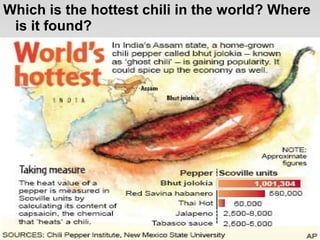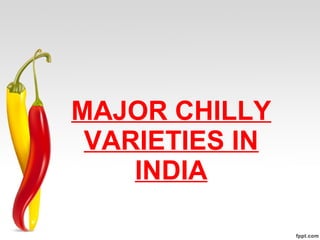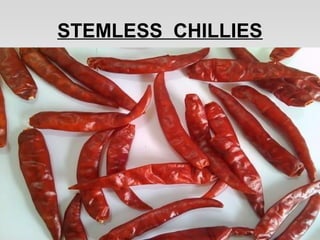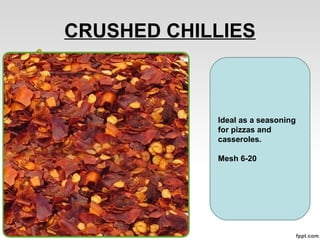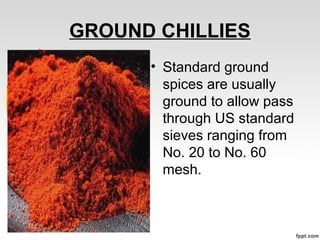RED CHILLY PROCESSING
- 1. RED CHILLY PROCESSING “Field to Fork“ BY-SENTHAMIZH SELVAN.T
- 2. Why is chili hot to taste Chili contains capsaicin, an alkaloid substance which makes chili hot to taste. Capsaicin is present in chili seeds and membranes. When chili powder is swallowed, capsaicin makes the brain to release a neurotransmitter called substance P.
- 3. When was chili introduced in India? In May 28, 1498, Chili was brought to India by the Portuguese explorer Vasco-da-Gama.
- 4. Which is the hottest chili in the world? Where is it found? “
- 5. What is the remedy if I have bured my mouth from eating too much of chili? Milk, Milk cream, curd, and other dairy products will reduce the burning sensation in your mouth. Drinking water will not help the situation.
- 6. WHY IT IS CALLED RED PEPPER? • Christopher Columbus, the founder of America, was one of the first Europeans who encountered and consumed chilli, and called it peppers due to the similarity in taste. • Columbus thought this was another variety of black pepper. • It is commonly called chilli pepper, red or green pepper, or sweet pepper in Britain. • Capsicum in Australian. • Bell pepper in the US and Canada. • Paprika in some other countries
- 7. History
- 8. INDIAN NAME OF SPICES Telegu –Mirapakaya Tamil- Mulagu Malayalam- Mulagu Kannada- Menashinakayi Hindi- La1 mirch (red), Hari mirch (green) Assami- Jolokia Bengali- Lanka, hforich Urdu- Lalmarach English- Cayenne pepper, Red pepper. Chilli, Chili
- 9. FOREIGN NAME OF SPICES Spanish : Pimenton French : Puvre de Guinee German : Paprika Arabic : Filfil Ahmar Dutch : Spaanse Peper Italian : Peperone Portuguese : Pimento Russian : Struchkovy pyeret Japanese : Togarashi Chinese : Hesiung Yali chiao British : Chillies(Hot) Pepper(Sweet)
- 10. MAJOR EXPORTERS,IMPORTERS,PRODUCERS,& CONSUMERS IN THE WORLD CONSUMERS EXPORTERS IMPORTERS PRODUCERS India India (25%) United Arab Emirates India (Asia) China China (24%) European Union China (Asia) Mexico Spain (17%) Sri Lanka Indonesia (Asia) Thailand Mexico (8%) Malaysia Korea (Asia) United States of America Pakistan (7.2%) Japan Pakistan (Asia) United Kingdom Morocco (7%) Korea Turkey (Asia) Germany Turkey (4.5%) China Sri Lanka (Asia)
- 14. CLASSIFICATION Kingdom : Plantae Division : Magnoliophyta Class :magnoliopsida Order :Solanales Family :Solanaceae Genus :capsicum Capsicum is derived from the Greek word "Kapsimo" meaning "to bite."
- 15. CLASSIFICATION OF CHILLIESCLASSIFICATION OF CHILLIES
- 16. CULTIVATION
- 17. CULTIVATION PATTERN Chilli is cultivated from sea level to 1,600 m Annual rainfall of 600-1,250mm. Optimum temperature-17-23°C. 2Seasons: 1. Sowing:May-June Harvest : October 2. Sowing: September Harvest : February.
- 19. 3.FLOWERING(1 or 2months) 3.FLOWERING(1 or 2months) 4.GREEN CHILLIES(1months) 5.RED CHILLIES(7-15 days) 5.RED CHILLIES(7-15 days)
- 20. • Chilli is a warm season crop • 1,250 g of seeds would be required to raise seedlings for planting an area of one hectare. • onion, brinjal Castor and coriander are grown as intercrops. • Yields 2-2.5 tonnes of dry chilli and 7.5- 10tonnes of green chilli from a hectare. • About four to five pickings are possible. • Moisture content of 65-80% reduced to 10%.
- 21. HARVESTING
- 24. SUNDRYING-5TO 15 DAYS depending on day temperature & Humidity OPTIMUM TEMPERATURE-65 -70 degree celsius SUNDRYING-5TO 15 DAYS depending on day temperature & Humidity OPTIMUM TEMPERATURE-65 -70 degree celsius DRYINGDRYING
- 25. SORTING/GRADING BASED ON :COLOUR,SIZE,STAGE OF MATURITY FRUIT IS SORTED/GRADED BY HAND EITHER ON A MOVING CONVEYOR OR ON A GRADING TABLE.
- 26. STORAGE • Cold storage temperature for chillies is 10 ± 2°C. • Under the storage conditions, the storage life of chillies is extended up to 10-12 days.
- 27. PACKAGING • The capacity of gunny bags is generally 20-25 kgs. in North Eastern States and in Punjab. • In Andhra Pradesh and Tamil Nadu, the pack size is more than 40 kg. & in Andhra Pradesh the pack size is even 100 kg.
- 28. TRANSPORTATION
- 35. HEAT VALUE-8000-15000 SHU ASTA COLOR VALUE-159.9 HEAT VALUE-8000-15000 SHU ASTA COLOR VALUE-159.9 BYADAGI • Grown in Dharwad and Bydagi region. • It is named after the district of Byadgi located in Haveri district of karnataka. • Second Largest turnover in chilli varieties of india. • A long pointed chili, dark red and strongly wrinkled. • It is much used in Goa and Karnataka, • It is considered essential to Marathi cuisine, valued for the bright red color it imparts. • It is also ground and sold as "Kashmiri Chili Powder“ . • Grown in Dharwad and Bydagi region. • It is named after the district of Byadgi located in Haveri district of karnataka. • Second Largest turnover in chilli varieties of india. • A long pointed chili, dark red and strongly wrinkled. • It is much used in Goa and Karnataka, • It is considered essential to Marathi cuisine, valued for the bright red color it imparts. • It is also ground and sold as "Kashmiri Chili Powder“ . • Grown in Dharwad and Bydagi region. • It is named after the district of Byadgi located in Haveri district of karnataka. • Second Largest turnover in chilli varieties of india. • A long pointed chili, dark red and strongly wrinkled. • It is much used in Goa and Karnataka, • It is considered essential to Marathi cuisine, valued for the bright red color it imparts. • It is also ground and sold as "Kashmiri Chili Powder“ . • Used for colour extraction. • This colour is highly popular among food and beverage processors for its use as a colouring agent. • Grown in Dharwad and Bydagi region. • It is named after the district of Byadgi located in Haveri district of karnataka. • Second Largest turnover in chilli varieties of india. • A long pointed chili, dark red and strongly wrinkled. • It is much used in Goa and Karnataka, • It is considered essential to Marathi cuisine, valued for the bright red color it imparts. • It is also ground and sold as "Kashmiri Chili Powder“ . • Used for colour extraction. • This colour is highly popular among food and beverage processors for its use as a colouring agent.
- 36. Ramnad Mundu/ Gundu Molzuka / Round ASTA COLOR VALUE-32.95 CAPSAICIN-0.17% ASTA COLOR VALUE-32.95 CAPSAICIN-0.17% • A small almost spherical chili with shiny skin, an orange-red color and medium heat. • It is grown particularly in the Ramnad district of Tamil Nadu and is used in that state, particularly in the Chettinad cuisine. • They ranged from 0.7 to 1.25 inches diameter with most around 1.0 inch • Harvesting season - March to May
- 37. NAGA JOLOKIA(or) GHOST CHILI SHU-855,000–1,041,427SHU-855,000–1,041,427 • This chili is grown in the far northeast of India, mainly the states of Nagaland, Assam and Manipur. • This chili is grown in the far northeast of India, mainly the states of Nagaland, Assam and Manipur.
- 38. TOMATO CHILLIES • Tomato Chilli (Warangal Chappatta), as the name suggests, is peculiar to the Warangal district of Andhra Pradesh. • They are short and deep red in colour and are slightly less pungent and milder in flavour. CAPSAICIN-0.17%%
- 39. BIRD’S EYE CHILLI(DHANI) These are used mainly in the far eastern states such as Assam, Mizoram, Manipur and Nagaland. adjacent to Burma. Blood red in colour, highly pungent Kerala & Thai cuisine cuisine ASTA COLOR VALUE-41.7 CAPSAICIN-0.59%
- 40. HINDUPUR –S7 Grown in Hindupur in Andhra Pradesh Red in colour, hot and highly pungent. Harvest Season: December to March. Grown in Hindupur in Andhra Pradesh Red in colour, hot and highly pungent. Harvest Season: December to March. ASTA COLOR VALUE-33.00 CAPSAICIN- 0.24% ASTA COLOR VALUE-33.00 CAPSAICIN- 0.24%
- 41. KASHMIRI CHILLI Grown in temperate regions such as Himachal Pradesh,Jammu & Kashmir and also in sub-tropical regions of North India during winter season. Long, fleshy,deep red in colour Harvesting season- November to February ASTA COLOR VALUE- 54.10 CAPSAICIN-0.325%
- 42. GUNTUR SANNAM-S4 TYPE It is grown in guntur district and also warangal,Prakasam and Khamam in AP. Sanam (telegu)-Thin and Long It is also known as334 Sannam Chillies Skin thick,hot and red Planting Season-October to May Harvesting season - December to May Annual Production - 2,80,000 tonnes Available in Guntur market They have thick red skin with high pungency and fieriness. It is mainly used for its pungency and for the extraction and derivation of capsaicin. ASTA COLOR VALUE-32.11 CAPSAICIN-0.226% Pungency (Heat) : 18000 SHU to 22000 SHU
- 43. WONDER HOT Wonder hot is widely used for making red chilli powder. Mostly grown in the fertile lands of Warangal which is located in Andhra Pradesh Length12 cms to 15 cms. Wonder Hot Chilli is large in size, less seeds, dark red ASTA COLOR VALUE-90- 120 CAPSAICIN-0.226% Pungency (SHU)8000 to 12000
- 44. TEJA CHILLIES-S17 Teja Chili is mostly grown in Andhra Pradesh, Karantaka, Maharashtra, Madhya Pradesh & Gujrat states of India. The harvesting season of Teja Chili is from December to March. Teja Chilly is small in size, thin in shape, normal seed content, bright red Length6 to 8 Cms (without stem) ASTA COLOR VALUE-50 ASTA – 60 ASTA CAPSAICIN- Pungency (Heat)75000 to 110000 SHU
- 45. KANTHARI-WHITE Grown in Kerala & some parts of Tamil Nadu Short and ivory white in colour with high pungency Chilies are very small in size(not more than 2-3 cm)yet pungent and hot, is often used in chutneys and pickles ASTA COLOR VALUE-2.96 CAPSAICIN-0.504%
- 46. MP G.T. SANAM CHILLIES Grown in Indore, Malkapur Chikli and Elachpur areas of Madhya Pradesh Harvesting season is from January to March. Red in color and pungent ASTA COLOR VALUE-73.82 CAPSAICIN-0.21%
- 47. INDO-5 CHILLIES It is majorly grown in the fertile lands of Andhra Pradesh, Karnataka and Maharashtra. The skin of Indo 5 is very thick as compared to other varieties of Indian Chillies and due to an additional feature of having a high heat values . it is considered to be most ideal for making Crushed chilli (chilli flakes) which is majorly consumed with pizzas and burgers worldwide. Indo 5 Chilli is also known as Indem- 5 Chilli, US- 5 and Endo 5 Chillies also t is thick, blood red in appearance, no wrinkle, less seeds contents.
- 48. PRODUCT TYPES
- 51. CHILLI SEEDS
- 52. CRUSHED CHILLIES Ideal as a seasoning for pizzas and casseroles. Mesh 6-20
- 53. CHILLI FLAKES It is widely used in preparation of snacks and sometimes used for garnishing. 10-30 mesh
- 54. GROUND CHILLIES • Standard ground spices are usually ground to allow pass through US standard sieves ranging from No. 20 to No. 60 mesh.
- 55. QUALITY FACTORS
- 56. The main quality factors in chillies are (i) colour, (ii) size, (iii) shape, (iv) seed content, (v) pungency, (vi) presence of dirt and other foreign matter. (vii) extent of damage and (viii) moisture content. • Moisture content higher than 15% is critical with respect to mould growth. • The usual limit of aflatoxins in chilli is 0.03 ppm.
- 57. HEAT AND COLOR • Chemical composition of the Capsicum includes Capsaicinoids and Carotenoids. • The pungency is based on the concentration of Capsaicinoids, primarily of capsaicin. • The capsaicin is concentrated in the placenta area (white pith where seeds are attached). 60% of capsaicin is in the white pith and 40% in the seeds. • Flavor is located Carotenoids, the color of the skin. The stronger the color, the stronger the flavor. • As the ground chili pepper ages, it lose the color and the flavor.
- 60. ADULTERATION • artificial dyes • almond shell dust, and • dried red beet pulp • coating with mineral oil or synthetic dyes such as coal tar red to improve the colour and appearance. • adding moisture to increase the weight of a load
- 62. AS PER REGULARION (FOOD REGULATIONS, 1955) THE MAXIMUM ALLOWABLE CONCENTRATION IN PPM OF SOME METAL POLLUTANRS IN CHILLI IS GIVEN BELOW:
- 64. MARKET TYPES
- 67. REFERENCES
- 68. THANKS FOR LISTENING!!!THANKS FOR LISTENING!!!




